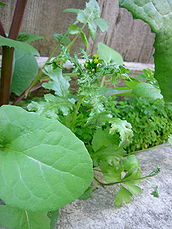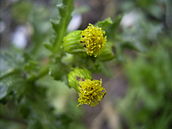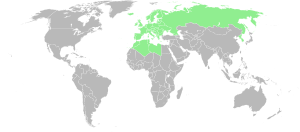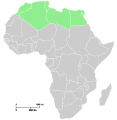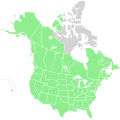- Senecio vulgaris
-
Senecio vulgaris 
Common groundsel Scientific classification Kingdom: Plantae (unranked): Angiosperms (unranked): Eudicots (unranked): Asterids Order: Asterales Family: Asteraceae Tribe: Senecioneae Genus: Senecio Species: S. vulgaris Binomial name Senecio vulgaris
L.[1]
Range of Senecio vulgaris Synonyms Senecio dunensis Dumort
Senecio radiatus W.D.J.Koch[2]Senecio vulgaris, often known by the common name Common groundsel, a humble in appearance member of the Asteraceae family and Senecio genus, is a tenacious deciduous annual whose presence now encompasses the globe in a wide area of easy to somewhat difficult growing conditions.
The discussion of Common groundsel dates back to the 1st century and more recently, it is the subject of much contradictory and reactionary information about where it came from, how it got there, whether is it really hurting the crops, how to get rid of it, and how dangerous it is when ingested by various animals.
Contents
Description
Standing only between 4 and 16 inches (10 to 41 cm) tall, bright florets mostly hidden by the characteristic bract giving it the appearance of never opening flowers and with a life span of 5–6 weeks, the self fertilizing Senecio vulgaris lives humbly among and occasionally under the other weeds and is easy not to notice.
- Leaves and stems
Leaves of Senecio vulgaris grow directly from the stem, sessile or lacking their own stem (petiole), alternating in direction along the length of the plant, two rounded lobes at the base of the stem (auriculate) and sub-clasping above. Leaves are pinnately lobed and +2.4 inches (61 mm) long and 1 inch (25 mm) wide and get smaller as up the plant. Leaves are covered sparsely with soft, smooth, fine hairs. Lobes typically sharp to rounded saw-toothed.[3][4]
The hollow[5] succulent stems branch at the tops and from the base.[3] Stems and leaves can both host the Cinerarea leaf rust.[6]
- Flowers
Open clusters of 8 to 10 small cylinder shaped rayless yellow flower heads ¼ to ½ inch (6 to 13 mm) with a highly conspicuous ring of black tipped bracts at the base of the inflorescence as is characteristic of many members of the genus Senecio.[3]
- Seeds
The name for the genus Senecio is probably derived from Senex (an old man), in reference to its downy head of seeds; "the flower of this herb hath white hair and when the wind bloweth it away, then it appeareth like a bald-headed man"[7] and like its family, flowers of Senecio vulgaris are succeeded by downy globed heads of seed. The seeds are achene, include a pappus[8] and become sticky when wet.[9] Laboratory tests have suggested maximum seed scattering distances of 2.1 and 3.2 yd (1.9 and 2.9 m) at wind speeds of 6.8 and 10.2 mph (10.9 and 16.4 km/h) respectively (affected by plant height)[6] suggests that it was more than wind that spread these groundsel seeds throughout the world.
The average weight of 1000 seeds is 0.21 gram (2,200,000 seeds per pound) and experienced a 100% germination success before drying and storage and an 87% germination success after drying and 3 years of cool dry storage.[10] In simple models for seed emergence prediction, soil thermal time did not predict the timing and extent of seedling emergence as well as hydrothermal time[11][12] (warm rain).
- Roots
The root system consists of a shallow taproot. This plant spreads by reseeding itself.[5]
Groundsel acts as a host for the fungus that causes black root rot in peas,[6] alfalfa, soybeans, carrots, tomatoes, red clover, peanuts, cucurbits, cotton, citrus, chickpeas, and several ornamental flowering plants; a list of flowering plants that can host their own fungus as well.
Common names
- English: Old-man-in-the-Spring, Common Groundsel, Groundsel, Ragwort, Grimsel, Grinsel, Grundsel, Simson, Birdseed, Chickenweed, Old-man-of-the-spring, Squaw Weed, Grundy Swallow, Ground Glutton, Common Butterweed[6][7][13][14][15][16]
- Portuguese: Cardo-morto [13]
- Norwegian: Åkersvineblom
- Danish: Almindelig Brandbæger
- Croatian: Badeljac, Guščernjak, Kostrič zečji, Obični dragušac, Obični kostriš, Obični staračac
- German: Gemeines Greiskraut, Gemeines Kreuzkraut, Gewöhnliches Greiskraut
- Estonian: Harilik ristirohi
- Maltese: Ħaxixa tal-Kanali, Kubrita
- French: Herbe aux coitrons, Séneçon commun, Séneçon vulgaire
- Galician: Mexacán
- Catalan: Xenixell
- Dutch: Klein kruiskruid
- Swedish: Korsört, Vanlig korsört
- Icelandic: Krossgras
- Slovene: Navadni grint
- Lithuanian: Paprastoji žilė
- Latvian: Parastā krustaine
- Finnish: Peltovillakko
- Polish: Starzec zwyczajny
- Italian: Senecione comune
- Spanish: Hierba cana, senecio común, flor amarilla, cineraria o yuyito
- Slovak: Starček obyčajný
- Hebrew: סַבְיוֹן פָּשׁוּט סביון פשוט
- Romanian: Cruciuliţă[17]
- Russian: Крестовник обыкновенный[18]
- Chinese: 歐洲黃菀
- Chinese: 欧洲千里光[19]
- Japanese: ノボロギク、野襤褸菊[20]
Distribution
Senecio vulgaris is a frost resistant[3] deciduous annual plant that grows willingly in disturbed sites, waste places, roadsides, gardens, nurseries, orchards, vineyards, landscaped areas, agricultural lands,[14] at altitudes up to 1,600 feet (500 m)[3] and is, additionally, self-pollinating[14] producing 1,700 seeds per plant with three generations per year.[21] Seeds are dispersed by wind and also cling to clothing and animal fur,[6] and as contaminates of commercially exchanged seeds; the relocation of this plant throughout the planet has been difficult if not impossible to contain.
There is conflicting information about the native status of Senecio vulgaris in various locations. The United States Department of Agriculture (USDA), Natural Resources Conservation Service Plants Profile Database[22] considers it to be native to all 50 of the United States of America, Canada, Greenland, Saint Pierre and Miquelon,[1] the same USDA through the Germplasm Resources Information Network (GRIN)[23] considers it to be native only to parts of Afro-Eurasia.[13] The Integrated Taxonomic Information System Organization (ITIS), a partnership between many United States federal government departments and agencies[24] states that the species has been introduced to the 50 United States,[25] and the online journal Flora of North America calls it "probably introduced" to areas north of Mexico.[26] Individual research groups claim it is not native to areas they oversee: Florida,[27] Washington,[28] Wisconsin,[29] Saskatchewan,[30] British Columbia,[31] Missouri.[32] The United States Geological Survey reports that Common Groundsel is exotic to all 50 states and all Canadian provinces with the exception of Georgia, Kentucky, Massachusetts, and Labrador.[33]
Native[13]
- Senecio vulgaris is considered to be native to Algeria, Libya, Morocco, Tunisia, Georgia, Republic of Adygea, Karachay-Cherkess Republic, Kabardino-Balkaria Republic, Republic of North Ossetia-Alania, Republic of Ingushetia, Chechen Republic, Republic of Dagestan, Amur Oblast, Chukotka Autonomous Okrug, Jewish Autonomous Oblast, Kamchatka Oblast, Koryak Autonomous Okrug, Khabarovsk Krai, Magadan Oblast, Primorsky Krai, Sakha (Yakutia) Republic, Sakhalin Oblast, South Korea, North Korea, Denmark, Faroe Islands, Finland, Iceland, Ireland, Norway, Sweden, United Kingdom, Austria, Belgium, Czech Republic, Slovakia, Germany, Hungary, Netherlands, Poland, Switzerland, Belarus, Estonia, Latvia, Lithuania, Moldova, Russian Central Federal District, Russian Southern Federal District, Ukraine, Albania, Bulgaria, Greece, Italy, Romania, Bosnia and Herzegovina, Croatia, the Republic of Macedonia, Montenegro, Serbia, and Slovenia, France and Portugal.
Current[1][13][18][26][34][35][36][37][38][39][40][41][42]
- America
- Canada: Alberta, British Columbia, Manitoba, New Brunswick, Newfoundland and Labrador, Northwest Territories and Nunavut (not collected North of the Hudson Bay), Nova Scotia, Ontario, Prince Edward Island, Quebec, Saskatchewan, Yukon.
- Mexico: Aguascalientes, Baja California Norte, Chiapas, Coahuila, Distrito Federal, Hidalgo, Jalisco, Estado de México, Nuevo León, Puebla, Tlaxcala, Veracruz
- North America: United States of America, Greenland, Saint Pierre and Miquelon
- South America: Argentina, Bolivia, Chile, Ecuador, Peru
- Africa
- Asia
- Western Asia: Iran, Israel with the Palestinian territories, Lebanon and Syria.
- Caucasus: Adygea, Azerbaijan, Chechnya, Dagestan, Georgia, Ingushetia, Kabardino-Balkaria, Kalmykia, Karachay-Cherkessia, North Ossetia-Alania
- Northwestern Asia: Arkhangelsk Oblast including Nenets Autonomous Okrug and Novaya Zemlya, Astrakhan Oblast, Bashkortostan, Belgorod Oblast, Bryansk Oblast, Chuvashia, Lipetsk Oblast, Kaliningrad Oblast, Kaluga Oblast, Novgorod Oblast, Republic of Karelia, Kirov Oblast, Komi Republic, Kursk Oblast, Mordovia, Murmansk Oblast, Orenburg Oblast, Penza Oblast, Perm Krai, Pskov Oblast, Rostov Oblast, Ryazan Oblast, Saint Petersburg, Samara Oblast, Saratov Oblast, Tambov Oblast, Tatarstan, Tula Oblast, Udmurtia, Volgograd Oblast, Vologda Oblast, Voronezh Oblast,
- Siberia: Altai Krai, Buryatia, Chelyabinsk Oblast, Chita Oblast, Irkutsk Oblast, Kemerovo Oblast, Krasnoyarsk Krai, parts of Kurgan Oblast, Novosibirsk Oblast, Omsk Oblast, Sverdlovsk Oblast, Tomsk Oblast, Tuva, Tyumen Oblast, Ulyanovsk Oblast, Yamal-Nenets,
- Soviet Far East: Amur Oblast, Chukotka Autonomous Okrug, Jewish Autonomous Oblast, Kamchatka Oblast, Koryak Autonomous Okrug, Khabarovsk Krai, Magadan Oblast, Primorsky Krai, Sakha (Yakutia) Republic, Sakhalin Oblast
- China: Inner Mongolia, Heilongjiang, Jilin, Liaoning, Hebei and Beijing
- Eastern Asia: South Korea, North Korea, Hokkaidō, Honshū, Shikoku, Kyūshū, Okinawa Island
- Europe
- Northern Europe: Channel Islands, Denmark, Estonia, Faeroe Islands, Finland, Iceland, Ireland with Northern Ireland, Norway, Sweden, United Kingdom
- Middle Europe: Austria, Czech Republic, Germany, Poland, Slovakia, Slovenia,
- East Europe: Belarus, Hungary, Latvia, Lithuania, Moldavia, Ukraine
- Southeastern Europe: Bosnia and Herzegovina, Bulgaria, Croatia, Republic of Macedonia, Montenegro, Romania, Serbia
- Southwestern Europe: Andorra, Azores, Balearic Islands, Canary Islands, Gibraltar, Portugal, Spain
- West Europe: Belgium, France, Liechtenstein, Luxembourg, Netherlands, Switzerland,
- South Europe: Albania, Chios, Corsica, Crete, Cyprus, Dodecanese, Greece, Ikaria, Italy, Karpathos, Lesbos, Samos Island, San Marino, Sardinia, Sicily with Malta, Asiatic Turkey and Turkey-in-Europe, Vatican City
- Oceania
- Australasia: Jarrah Forest, Swan Coastal Plain, Warren, New Zealand
- Range maps for continents
Predators
The seed of Common groundsel is a good green food for Canaries and Finches and it is available all year round.[6]
Senecio vulgaris seed has been found in the droppings of sparrows, and seedlings have been raised from the excreta of various birds. Seed has also been found in cow manure.[6]
Some Lepidoptera species eat many of the Senecio genus;[3] additional studies via electrophysiological recordings have shown that the taste sensilla of the Cinnabar moth larvae respond (get excited) specifically to the pyrrolizidine alkaloids, which all Senecio are known to contain.[43]
Moths and caterpillars[14][44]
- Cinnabar moth (Tyria jacobaeae)
- Flame Shoulder (Ochropleura plecta)
- Ragwort plume moth (Platyptilia isodactyla)
The Senecio genus also are host to other insects[14][45][46]:
Beetles
- Ragwort flea beetle (Longitarsus jacobaeae)
- Longitarsus gracilis (family Coleoptera species Chrysomelidae)
Flies
- Seed flies (Diptera: Muscoidea)
- Ragwort seed fly (Anthomyiidae, Botanophila seneciella)
- Gall flies (Diptera: Tephritidae):
- Ensina sonchi
- Sphenella marginata
- Trupanea stellata
- Trypeta zoe
and other insects that are not listed here.
The ragwort flea beetle and ragwort seed fly have been approved and released for Senecio control in California,[14] Australia[45] and elsewhere.
Fungus Most Senecio, including S. squalidus are susceptible to rust and other fungus and mildews[3][46][47]:
- Rust fungus Uredinales
- Coleosporium tussilaginis - stems and leaves (Coleosporiaceae)
- Puccinia lagenophorae - leaves only (Pucciniaceae)
- Bremia lactucae
- White rust Peronosporales
- Albugo tragopogonis - (Albuginaceae)
- some of the species Peronosporaceae - (Albuginaceae)
- Sac fungus Ascochyta, Pezizomycetes
- Ascochyta senecionicola - (Coelomycete)
- Groundsel Mildew Erysiphales
- Golovinomyces cichoracearum var. fischeri
- Powdery Mildew Erysiphales
- Podosphaera fusca - (Erysiphaceae)
- Black root rot Microascales
- some of the family Incertae sedis
and other fungus that are not listed here.
Reputation for being noxious and toxic
Senecio vulgaris has been listed as a noxious weed,[48] being both non-indigenous to most if not all of the Americas and having a reputation for being hepatotoxic to livestock[49] and to humans.[50][51][52]
Toxic versus medicinal
Human
As a plant that is reported to be both poisonous for human ingestion and also medicinal; much of the contradiction can be found by closely reviewing the words that are used and the dose (amount) of the poisonous substance that is ingested to prove either claim. All species of the genus Senecio contain pyrrolizidine alkaloids (e.g., senecionine) a substance that when a human has chronic exposure[53] can cause irreversible liver damage.[7][54]
Common groundsel as a medicinal herb does not seem to be recommended very often since 1931, when it was recommended as a diaphoretic, an antiscorbutic, a purgative, a diuretic and an anthelmintic, which was a demotion as it was previously suggested for the expelling of gravel of the kidneys and reins by Pedanius Dioscorides in the 70s-90s, for use as poultices by John Gerard in the late 16th century and as a cure for epilepsy by Nicholas Culpeper in the 17th century.[7] More current information is contradictory about the dangers of the ingestion of Groundsel. A heavily referenced paper from 1989 suggests that the response is immediate and gives pre-ambulatory care recommendations.[50] A Canadian poisonous plants information database references a paper from 1990 in presenting this prenatal warning: "In a case of prenatal exposure, a mother ingested tea containing an estimated 0.343 milligram of senecionine, resulting in fatal veno-occlusive disease in a newborn infant."[54] Information about the pyrrolizidine alkaloids, the substance present in Senecio vulgaris is much less contradictory and all warn of accumulation of the alkaloid.[55][56][57][58]
Certain pyrrolizidine alkaloids are non-toxic precursors that are converted to toxic metabolites in the body in a process called toxification[59]
Livestock
Linnaeus is cited to have claimed that "goats and swine eat this common plant freely, cows being not partial to it and horses and sheep declining to touch it, but not only are caged birds fond of it (the seeds), but its leaves and seeds afford food for many of our wild species (rabbits were given as an example)."[7] More recent studies claim that the lethal amount that cattle or horses need to consume is 7% of their body weight (example: 50 pounds (23 kg) would need to be consumed by a cow weighing 700 pounds (318 kg)). Lesser amounts cause the liver to lose function but is not apparent until the animal is stressed (by new feed or location, pregnancy, a different toxin, etc.). Sheep and goats have rumen bacteria that detoxify the alkaloids and are able to consume twice their body weight of this and other species of genus Senecio.[21][60] The alkaloids responsible are not destroyed by drying or by fermentation in silage.[6]
Introduced versus invasive
Introduced species become invasive when they compete with natives or with crops. Senecio vulgaris is not known to be a strong competitor but it has been known to reduce mint production.[61] There is evidence that it is not a strong invasive and sometimes protective of critically endangered native plants.[62]
Control
The approximately 22 millimetres (0.87 in) long[63] pappus seeds of Senecio vulgaris, each plant capable of producing 25,000 or more seeds (1,700 seeds per plant are more likely) with three generations of the plant per year;[21] seeds that are widely dispersed by the wind,[64] have been identified as a contaminant of cereal and vegetable seeds[3] and a poison to some livestock; there is some inspiration to understand the growth stages and determine some control methods.
- Cultivation: Cultivation with the hand or tiller is a recommended method of controlling Senecio vulgaris from growing in gardens and planting fields; cultivate to a depth of 2 inches (51 mm). The plant does prefer to take root in disturbed soils, so cultivation rids new plants but also buries and stirs up new seeds so the cultivation needs to be repeated at 14-day intervals.[6] Seeds can still mature even when the plant has been killed;[49] seed from plants cut in flower had germination levels of 35%. Groundsel seed numbers increased in soil during a 2-year set-aside left fallow but not when there was a sown grass cover. The weed cannot live on grazed, trampled or mowed sites.[6]
- Biological: The pathogen rust fungus or Puccinia lagenophorae and the Cinnabar moth Tyria jacobaeae have both been used and studied in an attempt to control infestation of Senecio vulgaris.[65] One study showed that rust fungus infected Senecio vulgaris survived and actually used more of the available soil nutrients.[66] The cinnabar moth eats groundsel between June and August, but the seeds germinate and the plant grows as soon as the ground is warm enough (and after a warm rain),[11] making this an insufficient control almost everywhere groundsel can be found.[21]
- Chemical: Herbicides designed to control broadleaf plants are affective for controlling Senecio vulgaris in cereals and forage grasses but also will "control" broadleaf crops, such as mint, forage legumes,[61] strawberries,[67] carrots[68] and all other non-grass crops. There is also evidence that the plant develops an immunity to the chemical control.[69][70]
- Other: Groundsel seedlings with 2-6 leaves are tolerant of flame weeding but the seeds are susceptible to soil solarization.[3]
Subspecies synonyms
- Senecio vulgaris subsp. denticulatus (O.F. Muell.) P.D. Sell
- Senecio vulgaris var. dubius (Ledeb.) Franch., 1883
- Senecio vulgaris var. dubius Trautv., 1866
- Senecio vulgaris var. hibernicus Syme
- Senecio vulgaris var. vulgaris[71]
- Senecio vulgaris-humilis Batt. & Trab.[72]
References
- ^ a b c Natural Resources Conservation Service (NRCS). "Plants Profile, Senecio vulgaris L.". The Plants Database. United States Department of Agriculture,. http://plants.usda.gov/java/profile?symbol=SEVU. Retrieved 2008-01-29.
- ^ Royal Botanic Garden Edinburgh. "Flora Europaea Search Results matching vulgaris and Senecio". http://193.62.154.38/cgi-bin/nph-readbtree.pl/feout?FAMILY_XREF=&GENUS_XREF=Senecio&SPECIES_XREF=vulgaris. Retrieved 2008-02-01.
- ^ a b c d e f g h i Hedgerowmobile. "Groundsel (Senecio vulgaris)". Species lists. Hedgerows, Hedges and Verges of Britain and Ireland. http://hedgerowmobile.com/groundsel.html. Retrieved 2008-02-05.
- ^ Dan Tenaglia (2007-02-08). "Senecio vulgaris L.". Missouri Botanical Garden Press. http://www.missouriplants.com/Yellowalt/Senecio_vulgaris_page.html. Retrieved 2008-02-05.
- ^ a b John Hilty. "Common Groundsel (Senecio vulgaris)". Illinois Wildflowers. http://www.illinoiswildflowers.info/weeds/plants/cm_groundsel.htm. Retrieved 2008-02-07.
- ^ a b c d e f g h i j Henry Doubleday Research Association (October 2007). "Groundsel". Organic Weed Management. Garden Organic. http://www.gardenorganic.org.uk/organicweeds/weed_information/weed.php?id=41. Retrieved 2008-02-05.
- ^ a b c d e M. Grieve (1931). "Groundsel, Common". A Modern Herbal. © Copyright Protected 1995-2008 Botanical.com. http://www.botanical.com/botanical/mgmh/g/grocom41.html#com. Retrieved 2008-02-02.
- ^ OMAFRA Staff (2002-06-01). "Ontario Weeds: Common groundsel". Publication 505, Ontario Weeds. Government of Ontario, Canada. http://www.omafra.gov.on.ca/english/crops/facts/ontweeds/common_groundsel.htm. Retrieved 2008-02-07.
- ^ O.W. Archibold, L. Wagner (2005-01-03). "Volunteer vascular plant establishment on roofs at the University of Saskatchewan". Landscape and Urban Planning. Elsevier. pp. Pages 20–28. doi:10.1016/j.landurbplan.2006.03.001. http://www.sciencedirect.com/science?_ob=ArticleURL&_udi=B6V91-4JW11WY-2&_user=10&_rdoc=1&_fmt=&_orig=search&_sort=d&view=c&_acct=C000050221&_version=1&_urlVersion=0&_userid=10&md5=9171a7b3e964581517be71277aef142a. Retrieved 2008-02-05. "The seeds of two species, thyme leaved spurge (Euphorbia glyptosperma) and groundsel (Senecio vulgaris), become sticky when wet and two others, ..."
- ^ Royal Botanic Gardens, Kew. "Search Results Senecio vulgaris". Seed Information Database. Board of Trustees of the Royal Botanic Gardens, Kew. http://data.kew.org/sid/SidServlet?Source=epic&ID=840&Num=yVd. Retrieved 2008-02-01.
- ^ a b Milt McGiffen, Kurt Spokas, Frank Forcella, David Archer, Steven Poppe, and Rodrigo Figueroa (March 2007). "Emergence Prediction of Common Groundsel (Senecio Vulgaris)". BioOne. pp. Volume 56, Issue 1 (January 2008) pp. 58–65. doi:10.1614/WS-07-060.1. http://www.bioone.org/perlserv/?request=get-abstract&doi=10.1614%2FWS-07-060.1. Retrieved 2008-02-01.
- ^ Rodrigo Figueroa, Douglas Doohan, John Cardina, and Kent Harrison (July 2006). "Common Groundsel (Senecio vulgaris) Seed Longevity and Seedling Emergence". BioOne. pp. Volume 55, Issue 3 (May 2007) pp. 187–192. doi:10.1614/WS-06-122R1.1. http://www.bioone.org/perlserv/?request=get-document&doi=10.1614%2FWS-06-122R1.1. Retrieved 2008-02-01.
- ^ a b c d e Germplasm Resources Information Network (GRIN) (2007-05-04). "Taxon: Senecio vulgaris L.". Taxonomy for Plants. USDA, ARS, National Genetic Resources Program, National Germplasm Resources Laboratory, Beltsville, Maryland. http://www.ars-grin.gov/cgi-bin/npgs/html/taxon.pl?33708. Retrieved 2008-01-27.
- ^ a b c d e f California Department of Food and Agriculture. "Senecio genus". Encycloweedia. State of California. http://www.cdfa.ca.gov/phpps/ipc/weedinfo/senecio.htm. Retrieved 2008-01-31.
- ^ Dr. Alice B. Russell, Department of Horticultural Science, North Carolina State University (1997). "Poisonous Plants: Senecio spp.". Poisonous Plants of North Carolina. http://www.ces.ncsu.edu/depts/hort/consumer/poison/poison.htm. Retrieved 2008-02-02.
- ^ Peterson Field Guide, Theodore F. Niehaus (1976) [1976]. Pacific States Wildflowers. The Peterson Field Guide Series. Illustrations by Charles L. Ripper. New York, New York 100003: Houghton Mifflin Company. pp. 208. ISBN 0-395-91095-1.
- ^ Lucia Popovici, Constanța Moruzi, Ion Toma - Atlas botanic, Editura didactică și pedagogică, București, 1985, pp. 23
- ^ a b Botanic Garden and Botanical Museum Berlin-Dahlem. "Details for: Senecio vulgaris". Euro+Med PlantBase. Freie Universität Berlin. http://ww2.bgbm.org/EuroPlusMed/PTaxonDetail.asp?NameId=128296&PTRefFk=7000000. Retrieved 2008-01-27.
- ^ Flora of North America. "Chinese Plant Names Senecio vulgaris L.". Chinese Plant Names. http://www.efloras.org/florataxon.aspx?flora_id=3&taxon_id=200024490. Retrieved 2008-02-01.
- ^ "ノボロギク" (in Japanese). http://ja.wikipedia.org/wiki/ノボロギク. Retrieved 2008-02-03.
- ^ a b c d Susan Aldrich-Markham, Oregon State University (July 1994). "Common Groundsel Senecio vulgaris L., PNW 466". Pests in Gardens and Landscapes. Oregon State University Cooperative extension service. Archived from the original on 2008-01-20. http://web.archive.org/web/20080120212354/http://extension.oregonstate.edu/catalog/html/pnw/pnw466/. Retrieved 2008-02-02.
- ^ Natural Resources Conservation Service (NRCS). "The Plants Database". United States Department of Agriculture,. http://plants.usda.gov/index.html. Retrieved 2008-02-01.
- ^ Germplasm Resources Information Network (GRIN) (2007-10-29). "National Plant Germplasm System". Germplasm Resources Information Network. USDA, ARS, National Genetic Resources Program, National Germplasm Resources Laboratory, Beltsville, Maryland. http://www.ars-grin.gov/npgs/. Retrieved 2008-02-01.
- ^ Integrated Taxonomic Information System Organization (ITIS) (2002-09-09). "About ITIS". Integrated Taxonomic Information System on-line database. http://www.itis.gov/organ.html. Retrieved 2008-02-01.
- ^ Integrated Taxonomic Information System Organization (ITIS) (2007-12-20). "Senecio vulgaris". Integrated Taxonomic Information System on-line database. http://www.itis.gov/servlet/SingleRpt/SingleRpt?search_topic=TSN&search_value=36194. Retrieved 2008-01-29.
- ^ a b Flora of North America. "37. Senecio vulgaris Linnaeus". pp. Vol. 20 Page 548, 562, 563. http://www.efloras.org/florataxon.aspx?flora_id=1&taxon_id=200024490. Retrieved 2008-02-01.
- ^ Richard Wunderlin or Bruce Hansen (2006). "Senecio vulgaris L.". Atlas of Florida Vascular Plants. Institute for Systematic Botany. http://www.plantatlas.usf.edu/main.asp?plantID=1806. Retrieved 2008-02-01.
- ^ Don Knoke (2006). "Asteraceae - Senecio: Senecio vulgaris". Vascular Plants. Burke Museum of Natural History and Culture. http://biology.burke.washington.edu/herbarium/imagecollection.php?Genus=Senecio&Species=vulgaris. Retrieved 2008-02-01.
- ^ University of Wisconsin–Stevens Point. "Senecio vulgaris L.". Robert W. Freckmann Herbarium. http://wisplants.uwsp.edu/scripts/detail.asp?SpCode=SENVUL. Retrieved 2008-02-01.
- ^ Government of Saskatchewan (2007). "Common Groundsel". Weed Identification Guide. http://www.agriculture.gov.sk.ca/Default.aspx?DN=a3e0e755-065f-4370-b6c5-df88957cb8f1. Retrieved 2008-02-01.
- ^ Center for Biological Informatics of the U.S. Geological Survey. "Weeds of British Columbia Listed by Common Name". http://export.nbii.gov/xml/web-resources/xmlfiles/ISN/56962.html. Retrieved 2008-02-01.
- ^ Flora of North America. "Flora of Missouri Senecio vulgaris Linnaeus". http://www.efloras.org/florataxon.aspx?flora_id=11&taxon_id=200024490. Retrieved 2008-02-01.
- ^ United States Geological Survey (2006). "Nature Serve Species Profile for Old-man-in-the-spring (Senecio vulgaris)". NatureServe. NatureServe’s Central Databases. Arlington, VA. U.S.A. http://export.nbii.gov/xml/natureserv/html/Asteraceae/1/ELEMENT_GLOBAL_2_161652.html. Retrieved 2008-02-01.
- ^ "Senecio vulgaris L." (in Spanish). Primera página de la especie. Malezas de México. http://www.conabio.gob.mx/malezasdemexico/asteraceae/senecio-vulgaris/fichas/ficha.htm. Retrieved 2008-01-30.
- ^ Global Biodiversity Information Facility. "Species: Senecio vulgaris L. Common Groundsel". Species Data. GBIF Data Portal. http://data.gbif.org/species/13748882. Retrieved 2008-02-08.
- ^ "Japanese Wild Flowers Senecio vulgaris". Prof. Summer's Web Garden. 2007-12-31. http://www7a.biglobe.ne.jp/~flower_world/Asteraceae/Senecio vulgaris.htm. Retrieved 2008-02-03.[dead link]
- ^ European crop wild relative diversity assessment and conservation forum (2005). "PGR Forum Crop Wild Relative Catalogue for Europe and the Mediterranean Senecio vulgaris". CWR Case Studies. Crop Wild Relative Information System. http://www.pgrforum.org/cwris/cwris.asp?fact=563342. Retrieved 2008-02-05.
- ^ Helen Coleman, FloraBase: Flora of Western Australia (1997-06-18). "Senecio vulgaris L.". Flora Descriptions. Government of Western Australia. http://florabase.calm.wa.gov.au/browse/profile/8220. Retrieved 2008-02-03.
- ^ Andrew J. Lowe and Richard J. Abbott (1998-10-30). "Routes of origin of two recently evolved hybrid taxa: Senecio vulgaris var. hibernicus and York radiate groundsel (Asteraceae)". American Journal of Botany. Botanical Society of America. pp. 2000;87:1159–1167. http://www.amjbot.org/cgi/content/full/87/8/1159. Retrieved 2008-02-03.
- ^ Instituto Darwinion. "Asteraceae" (in (Spanish)) (PDF). Catálogo de las Plantas Vasculares de la República Argentina. II. Universidad de Buenos Aires. pp. 255. Archived from the original on 2007-12-13. http://web.archive.org/web/20071213194657/http://www.darwin.edu.ar/Publicaciones/CatalogoVascII/CatalogoVascII.asp. Retrieved 2008-03-05.
- ^ Flora of Chile. Volume 4 Asteraceae Senecio L.. 4. http://www.efloras.org/web_page.aspx?flora_id=60&page_id=1094. Retrieved 2008-03-06.
- ^ Flora of Israel Online. "Senecio vulgaris L.". Hebrew University of Jerusalem. http://www.flora.huji.ac.il/browse.asp?action=specie&specie=SENVUL. Retrieved 2008-03-06.
- ^ E. A. Bernays, T. Hartmann and R. F. Chapman (March 2004). "Gustatory responsiveness to pyrrolizidine alkaloids in the Senecio specialist, Tyria jacobaeae (Lepidoptera, Arctiidae)". Physiological Entomology. Blackwell Publishing. pp. Volume 29 Issue 1 Page 67–72. doi:doi:10.1111/j.1365-3032.2004.0366.x. http://www.blackwell-synergy.com/doi/abs/10.1111/j.1365-3032.2004.0366.x?cookieSet=1&journalCode=pen. Retrieved 2008-02-06.
- ^ D. A. Mclaren, J. E. Ireson, and R. M. Kwong (4–14 July 1999). "Biological Control of Ragwort (Senecio jacobaea L.) in Australia" (PDF). CRC for Weed Management Systems. X International Symposium on Biological Control of Weeds. pp. 67–79. http://www.invasive.org/publications/xsymposium/proceed/01pg67.pdf. Retrieved 2008-02-20. ""Its most common host is Marsh Ragwort (S. aquaticus)"
- ^ a b "ragwort seed fly". Invasive and Exotic Species. The Bugwood Network. November 9, 2004. http://www.invasive.org/browse/subimages.cfm?sub=4420. Retrieved 2008-02-20.
- ^ a b "Senecio squalidus L. (Oxford Ragwort)". BioImages: The Virtual Field-Guide (UK). http://www.bioimages.org.uk/HTML/T606.HTM. Retrieved 2008-02-14.
- ^ George Edward, Massee (2007-07-10) [1915]. Diseases of Cultivated Plants and Trees. The Macmillan company. pp. 160. ISBN 1406783641. http://books.google.com/?id=FNY5AAAAMAAJ&pg=PA160&dq=black+root+rot+Senecio. Retrieved 2008-02-06.
- ^ Natural Resources Conservation Service (NRCS). "Washington State-listed Noxious Weeds". Invasive and Noxious Weeds. United States Department of Agriculture,. http://plants.usda.gov/java/noxious?rptType=State&statefips=53. Retrieved 2008-02-01.
- ^ a b C. A. Wilen, University of California, Integrated Pest Management Program, San Diego County (2006-05-23). "Common Groundsel IMPACT". Pests in Gardens and Landscapes; Common Groundsel Management Guidelines. Statewide IPM Program, Agriculture and Natural Resources, University of California. http://www.ipm.ucdavis.edu/PMG/PESTNOTES/pn74130.html. Retrieved 2008-02-01.
- ^ a b Dr A. Furtado Rahde (September 1989). "Senecio Vulgaris L. (PIM 484)". Chemical Safety Information from Intergovernmental Organizations. International Programme on Chemical Safety. http://www.inchem.org/documents/pims/plant/senecio.htm. Retrieved 2008-02-05.
- ^ Ministry of Agriculture and Lands. "Common Groundsel Senecio Vulgaris". Weeds BC. Government of British Columbia. http://www.weedsbc.ca/weed_desc/com_ground.html. Retrieved 2008-02-01.
- ^ Cornell Poisonous Plants Database (2008-01-16). "Cornell University answers questions about California Bay Area plants". http://www.ansci.cornell.edu/cgi-bin/db2www/plfaq_frame.d2w/report2?num=17. Retrieved 2008-02-01.[dead link]
- ^ GreenFacts. "Chronic exposure". GreenFacts Glossary. http://www.greenfacts.org/glossary/abc/chronic-exposure.htm. Retrieved 2008-02-01.
- ^ a b Government of Canada (2006-05-30). "Notes on poisoning: Senecio vulgaris". Canadian poisonous plants. Canadian Biodiversity Information Facility. http://www.cbif.gc.ca/pls/pp/ppack.info?p_psn=126&p_type=all&p_sci=sci&p_x=px. Retrieved 2008-02-02.
- ^ M. Walderhaug, United States Food and Drug Administration (January 1992). "Bad Bug Book: Pyrrolizidine Alkaloids". Foodborne Pathogenic Microorganisms and Natural Toxins Handbook. FDA/Center for Food Safety & Applied Nutrition. http://www.fda.gov/Food/FoodSafety/FoodborneIllness/FoodborneIllnessFoodbornePathogensNaturalToxins/BadBugBook/ucm071047.htm. Retrieved 2008-02-05.
- ^ Subhuti Dharmananda, Ph.D.. "Safety issues affecting herbs: pyrrolizidine alkaloids". Institute for Traditional Medicine, Portland, Oregon. http://www.itmonline.org/arts/pas.htm. Retrieved 2008-02-05.
- ^ Prakash AS, Pereira TN, Reilly PE, Seawright AA. (1999-07-15). "Pyrrolizidine alkaloids in human diet.". National Center for Biotechnology Information, University of Queensland. http://www.ncbi.nlm.nih.gov/sites/entrez?cmd=Retrieve&db=PubMed&dopt=AbstractPlus&list_uids=10415431. Retrieved 2008-02-05.
- ^ Manitoba Agriculture, Food and Rural Initiatives (MAFRI) (June 2006). "Common Groundsel - Weeds - Manitoba Agriculture, Food and Rural Initiatives". Manitoba Agriculture, Food and Rural Initiatives (MAFRI) and Manitoba Agricultural Services Corporation. http://www.gov.mb.ca/agriculture/crops/weeds/fab37s00.html. Retrieved 2008-02-01.
- ^ Manuel Hernandez (2004-02-23). "Pyrrolizidine Alkaloids". Poisonous Plants Homepage. Animal Science at Cornell University. http://www.ansci.cornell.edu/plants/toxicagents/alkaloids/pyrrolizidine.html. Retrieved 2008-02-05.
- ^ Jennifer M. Duringer, Donald R. Buhler, A. Morrie Craig (November 2004). "Comparison of hepatic in vitro metabolism of the pyrrolizidine alkaloid senecionine in sheep and cattle". American Journal of Veterinary Research. American Veterinary Medical Association. pp. Vol. 65, No. 11, Pages 1563–1572. doi:10.2460/ajvr.2004.65.1563. http://avmajournals.avma.org/doi/abs/10.2460/ajvr.2004.65.1563. Retrieved 2008-02-05.
- ^ a b "Common Groundsel". Written Findings of the State Noxious Weed Control Board. Washington State's 2004 Noxious Weed list. 2004. http://www.nwcb.wa.gov/weed_info/Senecio_vulgaris.html. Retrieved 2008-02-03.
- ^ U.S. Fish and Wildlife Service (2002-06-19). "Endangered and Threatened Wildlife and Plants; Critical Habitat Designation for Sidalcea keckii (Keck's checkermallow)". Federal Register Online via GPO Access. United States Department of the Interior. pp. RIN 1018-AG93, Page 41669–41683. http://www.fws.gov/policy/library/02fr41669.html. Retrieved 2008-02-03.[dead link]
- ^ Department of Horticulture and Crop Science, Ohio State University. "Senecio vulgaris". Seed ID Workshop. Ohio State University Cooperative extension service. http://www.oardc.ohio-state.edu/seedid/single.asp?strID=437. Retrieved 2008-02-01.
- ^ "Seed Exchange". A public access seed bank - established 1911. J. L. Hudson, Seedsman. 2008-01-31. http://www.jlhudsonseeds.net/SeedExchange.htm. Retrieved 2008-02-05.
- ^ J. Frantzen and P. E. Hatcher (2004-11-24). "A fresh view on the control of the annual plant Senecio vulgaris". Integrated Pest Management Reviews. Springer Netherlands. doi:10.1023/A:1018436614685. http://www.springerlink.com/content/k001v270m571686g/. Retrieved 2008-02-03.
- ^ N. D. Paul and P. G. Ayres (1987-11-09). "Nutrient Relations of Groundsel (Senecio vulgaris) Infected by Rust (Puccinia lagenophorae) at a Range of Nutrient Concentrations II. Uptake of N, P and K and Shoot-Root Interactions". Annals of Botany Company. pp. 61: 499–506, 1988. http://aob.oxfordjournals.org/cgi/content/abstract/61/4/499. Retrieved 2008-02-03.
- ^ Leslie Huffman- Weed Management Specialist (Horticultural Crops)/OMAFRA. "Reducing Common Groundsel in Strawberry Fields". Government of Ontario, Canada. http://www.omafra.gov.on.ca/english/crops/hort/news/hortmatt/2007/25hrt07a2.htm. Retrieved 2008-02-03.
- ^ EWRS Working Group "Weed Management Systems in Vegetables", University of Perugia. "Weeds and weed management in carrots - a review". 11th EWRS (European Weed Research Society) Symposium 1999, Basel. Facoltà di Agraria - Università degli Studi di Perugia. http://www.agr.unipg.it/ewrsveg/summary_carrots.htm. Retrieved 2008-02-03.[dead link]
- ^ William B. McCloskey and Jodie S. Holt; University of California, Riverside, Botany and Plant Sciences Department (April 1990). "Triazine Resistance in Senecio vulgaris Parental and Nearly Isonuclear Backcrossed Biotypes Is Correlated with Reduced Productivity". Plant Physiology. American Society of Plant Biologists. pp. Vol. 92(4): pp. 954–962. http://www.pubmedcentral.nih.gov/articlerender.fcgi?artid=1062401. Retrieved 2008-02-01. "Isonuclear triazine-susceptible and triazine-resistant Senecio vulgaris L. biotypes were developed by making reciprocal crosses between susceptible and resistant biotypes...."
- ^ Michel Havaux, Society for Experimental Biology, 2005 (1989). "Comparison of Atrazine-Resistant and -Susceptible Biotypes of Senecio vulgaris L.: Effects of High and Low Temperatures on the in vivo Photosynthetic Electron Transfer in Intact Leaves". Journal of Experimental Botany. Oxford University Press. pp. Volume 40, Number 8, Pp. 849–854. http://jxb.oxfordjournals.org/cgi/content/abstract/40/8/849. Retrieved 2008-02-01. "The effects of temperature on the yield of in vivo modulated chlorophyll fluorescence were measured in intact leaves of atrazineresistant and -susceptible biotypes of the weed Senecio vulgaris L. ...."
- ^ Missouri Botanical Garden. "Tropicos Web display Senecio vulgaris L.". Nomenclatural and Specimen Data Base. Missouri State Library. http://mobot.mobot.org/cgi-bin/search_pick?name=Senecio+vulgaris. Retrieved 2008-02-01.
- ^ African Flowering Plants Database. "Senecio vulgaris L.". South African National Biodiversity Institute. http://www.ville-ge.ch/cjb/bd/africa/details.php?langue=an&id=98469. Retrieved 2008-02-16.
External links
 Data related to Senecio vulgaris at Wikispecies
Data related to Senecio vulgaris at Wikispecies  Media related to Senecio vulgaris at Wikimedia Commons
Media related to Senecio vulgaris at Wikimedia Commons  Media related to Tyria jacobaeae at Wikimedia Commons
Media related to Tyria jacobaeae at Wikimedia Commons  Senecio vulgaris at Wikibooks
Senecio vulgaris at Wikibooks
Further reading
Categories:- Senecio
- Flora of Europe
- Flora of the Mediterranean
- Flora of North America
- Flora of Central Mexico
- Flora of western South America
- Flora of Northern Africa
- Flora of the Middle East
- Flora of Russia
- Flora of East Asia
Wikimedia Foundation. 2010.

